Jeffrey Epstein‘s jailhouse death remains one of the most hotly debated and widespread conspiracy theories in recent American history since he was found dead in his cell while awaiting trial on sex trafficking charges in 2019.
But the Trump administration’s recent memo on the investigation has now reignited the firestorm after it reaffirmed that the disgraced financier’s death was a suicide and the FBI was concluding its review.
The decision has only continued to fuel public speculation of a cover-up that suggests Epstein was murdered in order to protect other high-profile individuals that were potentially complicit in his crimes.
It has also led to a re-examination of a damning 2023 report by the DOJ’s own Office of Inspector General (OIG) which laid out the shocking failures and procedural breakdowns that allowed Epstein to take his own life at the Metropolitan Correctional Center in Manhattan on August 10, 2019.
DailyMail.com has revisited the explosive 128-page report, which raises serious contradictions with the DOJ’s recent claims and blames ‘a combination of negligence, misconduct and outright job performance failures’ by the Bureau of Prisons.
At the heart of the controversy are these ten troubling questions that Attorney General Pam Bondi – who’s already facing backlash Trump supporters for her handling of the case – must answer about Epstein’s mysterious death.
1. Why was Epstein allowed to have two blankets and two extra mattresses the day before he was found dead?
The most damning detail in the OIG report is that Epstein was given two additional blankets and two more mattresses just one day before his death.

Attorney General Pam Bondi was pressed to explain a bizarre timestamp jump in the 11-hour surveillance footage leading up to Epstein’s death in August 2019
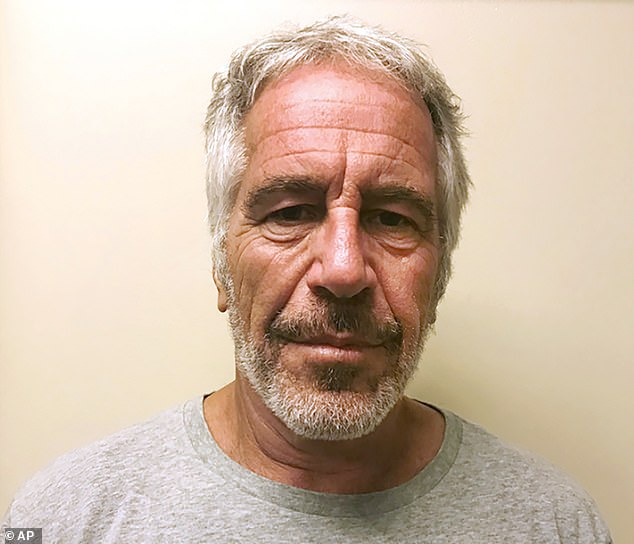
Epstein’s death being ruled a suicide had been hotly debated since the news broke but the Justice Department and FBI’s recent memo confirming that their findings are in line with the manner of death has reignited cover-up allegations
That day, August 9, 2019, another inmate, identified as ‘Inmate 3’ told the investigators that correction officers brought the mattresses in and put them on the floor.
Epstein put them on the right side of the cell. Inmate 3 also noticed the extra blankets which he thought was ‘unusual because none of the (other) inmates had extra blankets’
The report states: ‘Inmate 3 said he asked Epstein to please not kill himself or hang himself while Inmate 3 was his cellmate because Inmate 3 had a chance to go home soon.
‘Epstein told Inmate 3 not to worry and that he was not going to cause Inmate 3 any trouble’.
The following day, after Inmate 3 had been moved out of the cell, Epstein was found hanged with a bedsheet around his neck inside his cell.
The captain in charge of the SHU later reviewed photos from inside Epstein’s cell and found there were ‘too many linens, t-shirts and blankets’ there.
Having too many such materials in the room was a security issue as inmates could use them to try and escape or to make ‘improvised nooses’, the captain said.
2. Why were staff intimidated by Epstein?
Inmate 3 told the OIG that correctional officers were on ‘eggshells’ around Epstein who had told them that if they refused his requests he would write down their names and give them to his lawyer.
As a result Epstein was allowed to sleep on the floor which was not normal practice and could have explained why he was allowed to have the extra blanket and sheets.
Another irregularity was that the day he left Epstein’s cell, there was an orange cloth twisted around the ladder on the bunk which was a clothesline made up of a ripped sheet.
The report states: ‘According to Inmate 3, one night he woke up, saw Epstein fidgeting with the clothesline, and asked Epstein what he was doing.
‘Epstein said he was trying to fix the clothesline, but Inmate 3 told him no and flushed the clothesline down the toilet’.
3. What happened to the missing minute of surveillance footage?
As part of its memo released this week, the DOJ and FBI released 11 hours of footage from one of the security cameras showing the common area of the SHU that Epstein was housed in.
However, observers noted that one minute of footage was missing, sparking a slew of conspiracy theories and memes, including one which showed Hillary Clinton going into one of the cells.
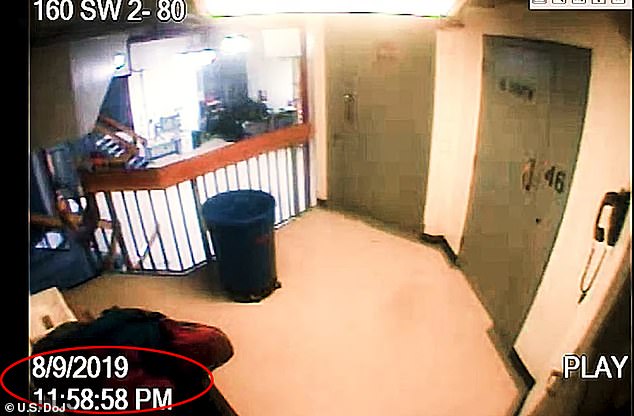
Video sees the time code of 11:58:58pm before it suddenly skips one minute to midnight
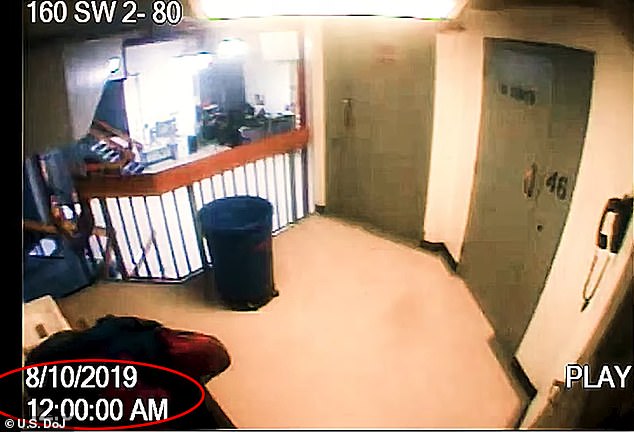
The next frame of footage sees an entire minute having been skipped over – said to be a quirk of the video system at Metropolitan Correctional Center
The footage showed the SHU from 1:59 pm on August 9, 2019 to 12am the next day.
Epstein died some time that night.
Attorney General Pam Bondi tried to explain the missing minute during a cabinet meeting when Trump was present.
She said that the Bureau of Prisons told her that the 60 seconds between 11:59pm and 12am is missing from all recordings in the prison because the footage is ‘reset’ each night.
Bondi said the video system was from 1999 and so it resets every night and every night one minute was missing.
She said: ‘So we’re looking for that video to release that as well, showing that a minute is missing every night’
In its memo, the DOJ and FBI leaned heavily on the video footage to support their statement that Epstein did commit suicide.
They wrote: ‘Anyone entering or attempting to enter the tier where Epstein’s cell was located from the SHU common area would have been captured by this footage.
‘The FBI’s independent review of this footage confirmed that from the time Epstein was locked in his cell at around 10:40 pm on August 9, 2019, until around 6:30am the next morning, nobody entered any of the tiers in the SHU’
4. Why were the cameras covering the door to Epstein’s cell streaming but not recording?
A stunning graphic in the OIG report reveals that the camera in the hallway where Epstein’s cell was located was not even recording.
The camera was streaming to the guards but was not recording so could not be reviewed afterwards.
The footage released by the DOJ and FBI came from the camera in the common area of the SHU, so Epstein’s cell was barely visible.
The OIG report details a catalog of technical issues with the surveillance camera system.
On August 8th, two days before Epstein was found dead, the Bureau of Prisons discovered that one of the two DVR recording systems was not working.
In fact it had been out of action since July 29, nearly two weeks earlier, but hadn’t been picked up until then.
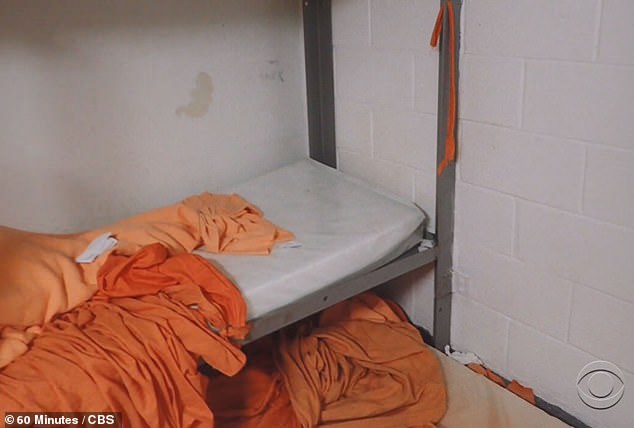
The inside of Epstein’s cell is seen after he killed himself in 2019
The technician who inspected the system found that of the 150 cameras in the prison, half were showing a live feed but were not recording.
The report stated: ‘The Electronics Technician told the OIG that, before Epstein’s death, no one was specifically tasked with ensuring that video from the cameras was being recorded.
‘The Electronics Technician said he therefore did not perform any daily checks to ensure that video was being recorded’.
The technician arrived at the MCC at 6am on August 10th to repair the DVR system but shortly afterwards, the alarm went off to say that staff had found Epstein’s body.
5. Was the footage of Epstein’s death doctored?
A report in Wired last week claimed that the 11 hours of footage was ‘modified’, likely using editing software Adobe Premiere Pro.
The report said that the footage, which Wired forensically examined, had been put together ‘from at least two source clips, saved multiple times, exported, and then uploaded to the DOJ’s website’.
There it was presented as ‘raw’ footage but that was not the case, the metadata of the video shows.
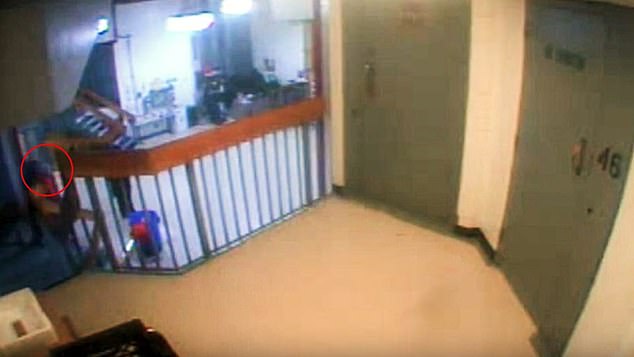
At one point, the footage appears to shows the orange jumpsuit-clad pedophile being led to his cells by a guard and being trailed by a second one
One lawyer quoted by Wired said: ‘If a lawyer brought me this file and asked if it was suitable for court, I’d say no. Go back to the source. Do it right. Do a direct export from the original system – no monkey business’.
6. Why was Epstein not properly monitored despite trying to kill himself two weeks before his death?
Two weeks before his death, on July 23rd 2019, Epstein was found in his cell with an orange cloth around his neck and his cellmate told prison staff he had tried to kill himself.
BOP policy requires that inmates identified as suicide risks be ‘placed on suicide watch until no longer at imminent risk’, the OIG report states.
But instead the BOP used a ‘less restrictive’ way of monitoring him.
That meant Epstein was removed from suicide watch the next day and remained under psychological observation until July 30th.
The prison psychologist who examined Epstein determined he needed to be housed with another inmate and emailed more than 70 MCC employees telling them about this requirement.
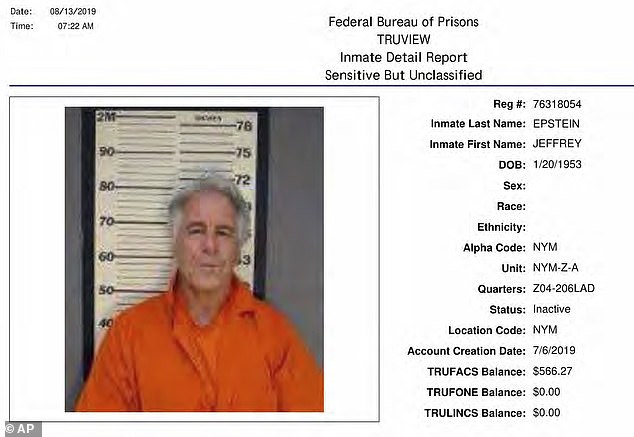
Prison records released in 2023 include a rarely seen mugshot of a disheveled Epstein in an orange prison jumpsuit
Epstein was indeed given a cellmate, Inmate 3, and he remained in Epstein’s cell until August 9, the day before he was found dead.
This was in spite of more than 2,000 pages of damning documents being unsealed that very day which painted the fullest picture yet of Epstein’s abuse of underage girls stretching back decades.
The documents would have made clear to Epstein the scale of the case against him and how likely he was to be found guilty if the case had gone to trial.
7. Why was the charges against the negligent prison guards dropped?
Epstein’s previous suicide attempt meant he was supposed to be under strict supervision in his cell.
But the night he died, the two correctional officers assigned to monitor him,failed to carry out 75 mandatory checks on him.
He was locked in his cell at 8pm on August 9 and found dead at 6:30am the following day when the guards went to serve him breakfast.
Records show the last time one of the two guards checked on Epstein was 10pm when they plugged in a medical device for him.
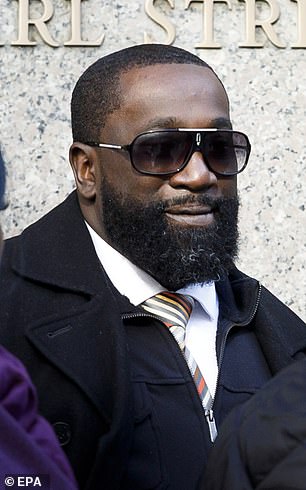
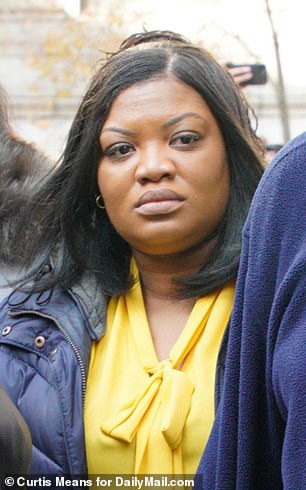
Prison guards Michael Thomas and Tova Noel (pictured in 2019) – who were assigned with watching Epstein that night – were charged with falsifying records but prosecutors decided to drop the case in December 2021
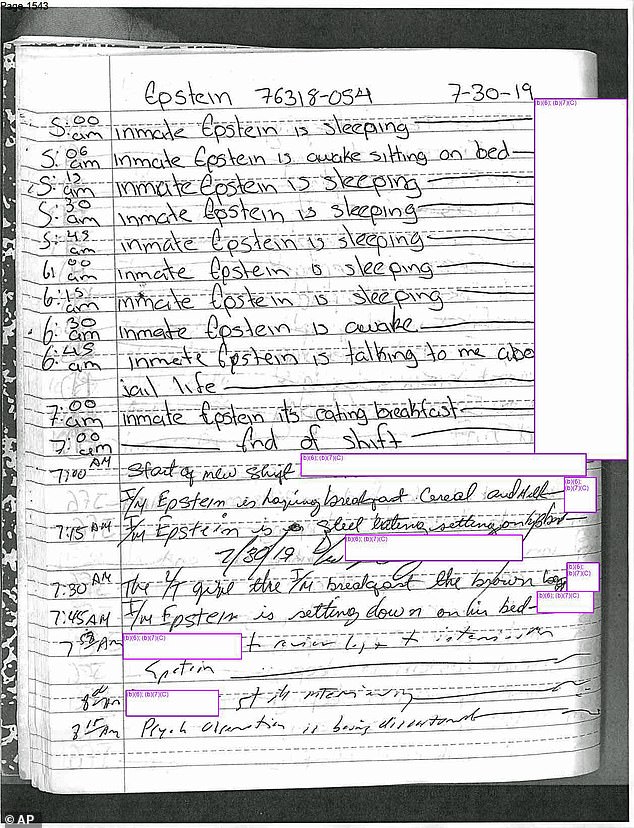
Pictured above is a suicide watch log monitoring Epstein’s behavior in July 2019, days before his death. The disgraced financier was required to be under strict supervision due to his previous suicide attempts
The two guards, Michael Thomas and Tova Noel, were later charged with fabricating records but prosecutors decided to drop the case in December 2021.
They admitted to ‘willfully and knowingly’ falsifying records to make it seem like they were doing proper checks on Epstein and agreed to perform 100 hours of community service.
As the OIG report states, the pair were sitting at their station 15 feet away from Epstein’s cell surfing the Internet instead of watching him.
The report states: ‘Noel used the computer periodically throughout the night, including to search the Internet for furniture sales and benefit websites and to read a news article about Epstein.
‘Thomas used the computer briefly around 1 am and 6 am to search for motorcycle sales and sports news’.
The report adds that between 1 am and 3 am both the guards appeared to be asleep.
One of the reasons they were so tired is that one of them had been forced to work a 16-hour double shift and the other volunteered to work the night shift, having already done many hours of overtime that week.
From Epstein’s cell window, he could have been able to see if the guards were asleep.
8. Why was Epstein allowed to call his girlfriend the night before he died?
In a breach of BOP policy, Epstein was allowed to use an unmonitored jail phone which was not recorded.
Epstein claimed to have been calling his mother but it later transpired he was calling Karyna Shuliak, his much younger Belarussian girlfriend, who was with him when he was arrested after flying to New York from Paris.
Shuliak had been with Epstein for years and, bizarrely, was a trained dentist: his victims have said that he would do work on their teeth if they were not to his taste.
9. Why was Epstein allowed to transfer money into other inmates’ commissary accounts?
A report into Epstein’s death by the New York Times claimed it could have been used to ‘buy protection’.
Epstein had been putting money into at least three other inmates’ accounts, which are normally used to buy discretionary items while inside prison.
10. Why was Epstein’s psychological evaluation after his first suicide attempt just five minutes?
The same New York Times report said that Epstein met with a therapist for just five minutes during one of his post suicide attempt check ups.
Epstein’s lawyer David Schoen even joked with Epstein and the therapist about how short the meeting had been.











